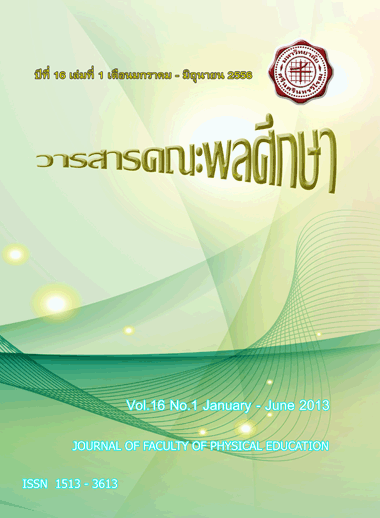THE DEVELOPMENT OF INSTRUCTIONAL MODEL FOR PHYSICAL EDUCATION FOR PROFESSIONAL TEACHERS,STUDENT IN INSTITUTE OF PHYSICAL EDUCATION
Abstract
Purpose : this research were to study factor, develop and study the results the use of Instructionalmodel for professional teacher students in the Institute of Physical Education.Methods : consisted of two phases, phase 1 : Study factor. Phase 2 : develop and study theresults the use of Instructional modelResults : of this research were as follows:1. The instructional model consisted of five factors.2. The instructional model development consists as follows: 1) Learning by Doing, AssociationTheory, and Cognitive Theory. 2.2) The objectives of the learning outcomes included TQF:HEd and SportSkill 2.3) The instructional steps consisted of seven steps. 2.4) Instructional activities used Sepak-takraw1 subject 2.5) The measurement and evaluation used achievement learning assessment of TQF:HEdand Sport Skill.3. The results of this instructional model used were as follows: 1) The result of the comparisonbetween Pre-test and Post-test assessment TQF:HEd and physical fitness, the scores of the Post-testwere significantly higher than those of the Pre-test at the level 0.05. 2) There was significant differencein the comparison of performance skill of Sepak-takraw in five pairs at the level of 0.05. However, therewas no significant difference in the other two pairs.Conclusion : of this research were as follows:1. The instructional model for physical education consisted of Learning Theory, Concept andPrinciple, Objectives, Instructional Procedures, Instructional Activity, and Measurement and Evaluation.2. The instructional model develop by researcher consisted of Learning by Doing, AssociationTheory, and Cognitive Theory, objectives of the learning outcomes included TQF:HEd and Sport Skill ,the instructional steps consisted of seven steps, instructional activities used Sepak-takraw 1 subject, themeasurement and evaluation used achievement learning assessment of TQF:HEd and Sport Skill. Thetest assessment, the scores of the Post-test were significantly higher than those of the Pre-test at thelevel 0.05.Downloads
Published
2013-11-07
Issue
Section
บทความวิจัย

